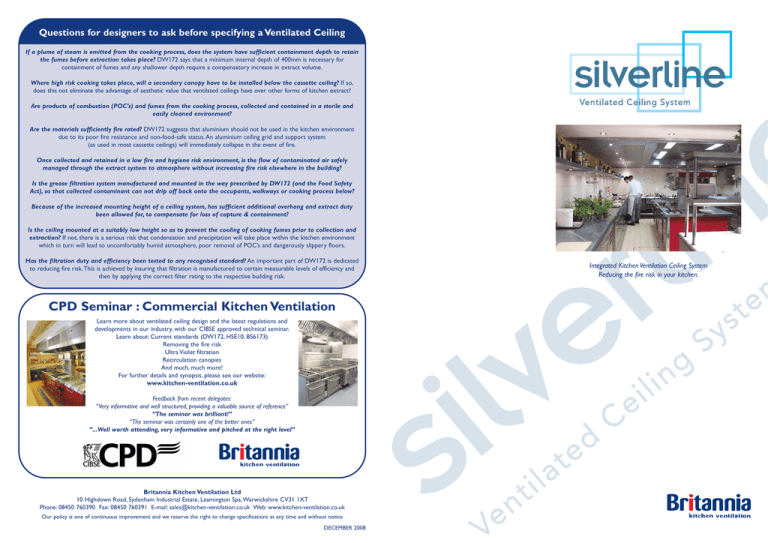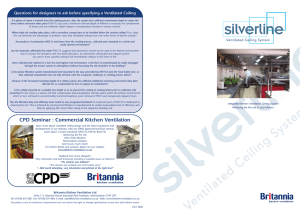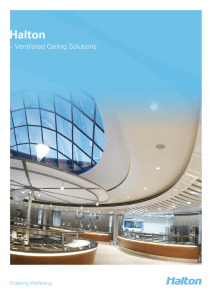Silverline Brochure - Kitchen Ventilation
advertisement

Questions for designers to ask before specifying a Ventilated Ceiling If a plume of steam is emitted from the cooking process, does the system have sufficient containment depth to retain the fumes before extraction takes place? DW172 says that a minimum internal depth of 400mm is necessary for containment of fumes and any shallower depth require a compensatory increase in extract volume. Where high risk cooking takes place, will a secondary canopy have to be installed below the cassette ceiling? If so, does this not eliminate the advantage of aesthetic value that ventilated ceilings have over other forms of kitchen extract? Are products of combustion (POC’s) and fumes from the cooking process, collected and contained in a sterile and easily cleaned environment? Are the materials sufficiently fire rated? DW172 suggests that aluminium should not be used in the kitchen environment due to its poor fire resistance and non-food-safe status. An aluminium ceiling grid and support system (as used in most cassette ceilings) will immediately collapse in the event of fire. Once collected and retained in a low fire and hygiene risk environment, is the flow of contaminated air safely managed through the extract system to atmosphere without increasing fire risk elsewhere in the building? Is the grease filtration system manufactured and mounted in the way prescribed by DW172 (and the Food Safety Act), so that collected contaminant can not drip off back onto the occupants, walkways or cooking process below? Because of the increased mounting height of a ceiling system, has sufficient additional overhang and extract duty been allowed for, to compensate for loss of capture & containment? Is the ceiling mounted at a suitably low height so as to prevent the cooling of cooking fumes prior to collection and extraction? If not, there is a serious risk that condensation and precipitation will take place within the kitchen environment which in turn will lead to uncomfortably humid atmosphere, poor removal of POC’s and dangerously slippery floors. Has the filtration duty and efficiency been tested to any recognised standard? An important part of DW172 is dedicated to reducing fire risk. This is achieved by insuring that filtration is manufactured to certain measurable levels of efficiency and then by applying the correct filter rating to the respective building risk. CPD Seminar : Commercial Kitchen Ventilation Learn more about ventilated ceiling design and the latest regulations and developments in our industry, with our CIBSE approved technical seminar. Learn about: Current standards (DW172, HSE10, BS6173) Removing the fire risk Ultra Violet filtration Recirculation canopies And much, much more! For further details and synopsis, please see our website: www.kitchen-ventilation.co.uk Feedback from recent delegates: “Very informative and well structured, providing a valuable source of reference” “The seminar was brilliant!” “The seminar was certainly one of the better ones” “...Well worth attending, very informative and pitched at the right level” Britannia Kitchen Ventilation Ltd 10 Highdown Road, Sydenham Industrial Estate, Leamington Spa, Warwickshire CV31 1XT Phone: 08450 760390 Fax: 08450 760391 E-mail: sales@kitchen-ventilation.co.uk Web: www.kitchen-ventilation.co.uk Our policy is one of continuous improvement and we reserve the right to change specifications at any time and without notice DECEMBER 2008 Integrated Kitchen Ventilation Ceiling System Reducing the fire risk in your kitchen. The Stainless Steel Ventilated Ceiling System For a refreshing approach to kitchen ventilation Complete kitchen ventilation system Proven safe technology to DW172 Provides clean line of sight across the kitchen Ceiling void not contaminated with grease Lower capital costs compared to other ceilings Reduced risk of fire spreading from kitchen Durable stainless steel construction (no aluminium) Integrated fire suppression system Reduced maintenance costs Calcot Manor Hotel – Gloucestershire Ventilated ceilings are increasingly popular as aesthetics become more important within commercial kitchens, because they provide a clean line of sight, whilst providing a comfortable and safe working environment. Conventional cassette type ceilings fall short of today's more stringent guidelines as detailed in DW172 and BS6173 : 2001. Conventional ventilated ceilings have increased fire and hygiene risks due to poor capture, containment and removal of contaminants from the cooking process. Conventional ventilated ceilings - the design risk Silverline provides an aesthetically pleasing solution whilst minimising the fire risk associated with most ceiling systems (see panel, right). Silverline is based on shallow conventional extract canopies, with the rest of the ceiling laid to grid with insulated stainless steel tiles, fixed light lanes and removable supply diffusers. The void above the ceiling acts as an air plenum introducing make-up air into the kitchen and is never in contact with extract air. Conventional ventilated ceiling systems use the ceiling void as an extract plenum. Due to the relative inefficiency of all grease filters, grease will be carried over and coat the void and the services that run within it. The photographs above illustrate that this void is difficult to clean and therefore creates a significant health & safety and fire risk. Garth Prison – Lancashire. (with filter locking mechanism) Silverline is usually mounted 2300mm above finished floor level and provides dedicated fire compartments above the cooking equipment. Each canopy section is fitted with Superstream baffle type filters and a grease collection and drainage systems and this prevents grease from reaching the ceiling void, minimising any fire risk. Each canopy section is ducted directly to atmosphere and can be fitted with a fire suppression system or Ultrastream UV filtration system to provide secondary grease removal and odour destruction. Center Parcs – Nottingham The remaining ceiling is made up of fixed light lanes, with recessed light fittings and 500 x 500mm removable panels. Most being insulated stainless steel, with supply air being introduced through diffuser panels. Cassette type ceilings use the structural void above as an extract plenum chamber. Grease carried over builds in the void, creating a significant fire hazard. The photograph above shows grease leaking out of a cassette type ceiling. Britannia have installed conventional canopies under cassette ceiling systems, as clients are nervous about their application and use, with particular regard to the fire safety in the structural void above. This clearly demonstrates the drawbacks of cassette ceilings.





